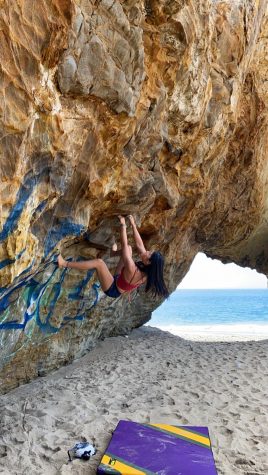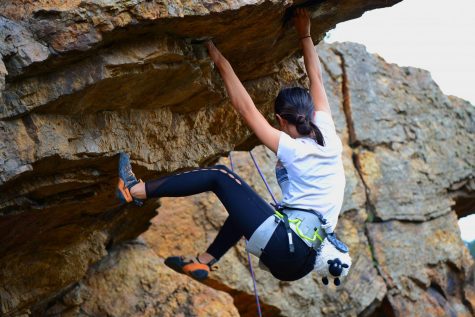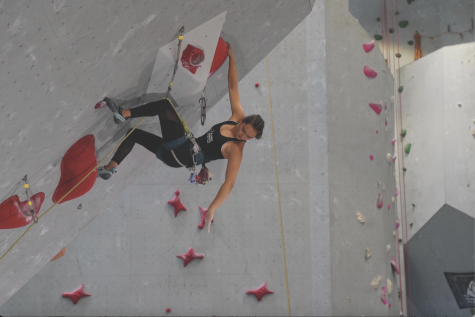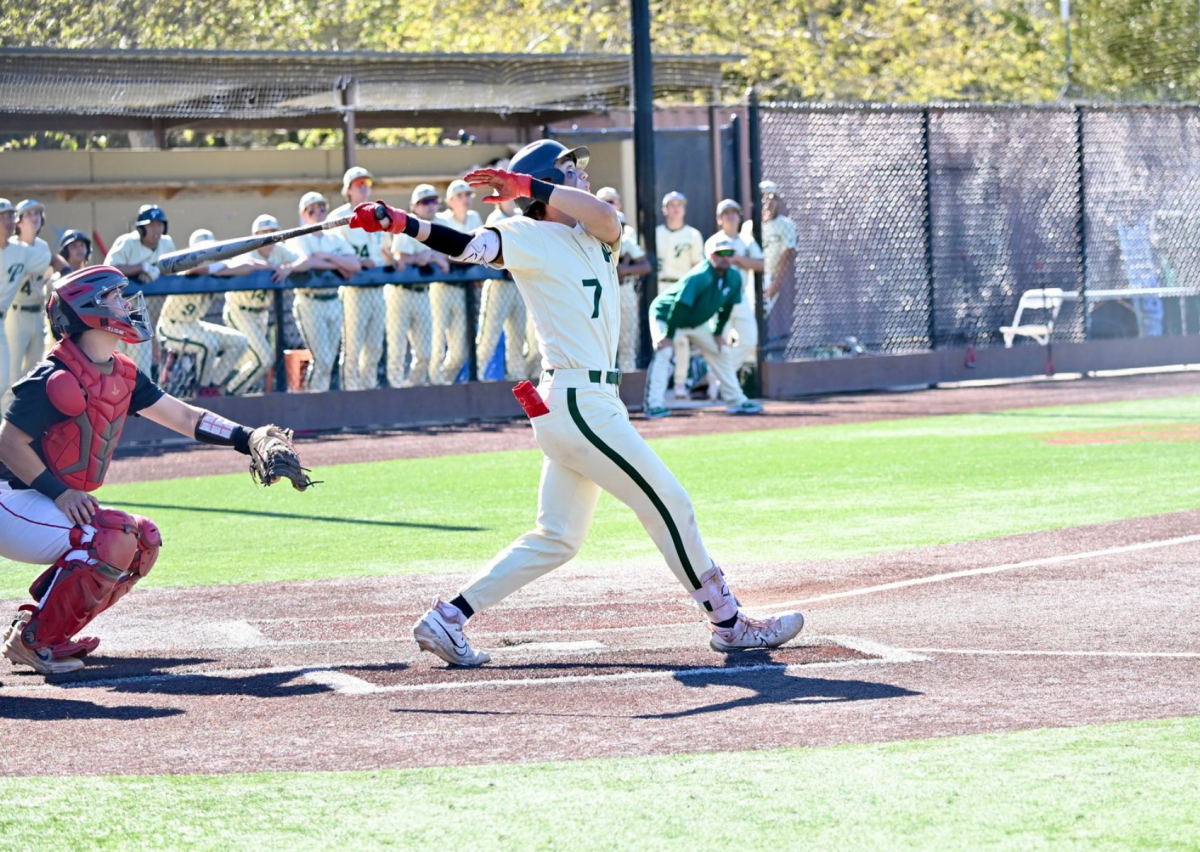Top of the Rock
May 8, 2021
With her hands white from chalk and feet crammed into climbing shoes, Tara He (‘22) looks up towards the rocky terrain she is about to scale, visualizing her plan of attack. As she starts to climb, her hands find the tiny crevices in the rock and her feet strain to balance on the ledge that protrudes out from the rocks surface. Hanging 20 feet above the ground, she makes the final push to the top and swings herself onto the flat surface. The climb is complete, and as He looks down at the height she scaled, a feeling of satisfaction spreads over her face. She hops down steadily from the top with her harness to protect her, ready to try it again.
Today, rock climbing has attracted many climbers like Tara who perform the sport as a hobby or even competitively. However, the original purpose of rock climbing was one of survival, with people climbing as a means of exploring new places, and finding new homes and food sources.
The gradual progression of rock climbing from a necessity to a sport began developing in the 19th century. As the years progressed, climbing tools such as ropes, belay devices, and harness systems were developed, making it easier for climbers to scale taller and taller mountains. As more people began practicing rock climbing, the popularity grew, and the activity was soon being recognized by many as a true sport.
There are many different types of rock climbing that people perform. Mountaineering, one of the oldest forms of rock climbing, requires an immense amount of skill, as climbers must safely navigate the rock on top of dealing with harsh weather conditions such as snow and ice. Trad climbing is a form of climbing where climbers use gear such as pitons and rope to protect against falls. More recently, the Olympics introduced a form of race climbing, where climbers race against one another to reach the top of a climbing wall. Perhaps one of the most dangerous forms of climbing is free solo climbing, where a climber scales a face without the use of any harnesses and ropes, meaning that there is nothing to protect them from a fall.
The recent rock climbing feats involving free climbing only further catapulted the sport to center stage. In 2017, climber Alex Honnold made history when he completed the first free solo climb of El Capitan, a 3000 foot granite beast that is one of the toughest conquests for climbers. The subsequent documentary, “Free Solo”, illustrated his journey on the climb and pushed rock climbing into the mainstream.
Tara He is one of the athletes who was swept into the sport during this spike in popularity. She simply lives and breathes climbing. It not only provides her with a physical outlet, but also mental health benefits and a thriving community.
“I got into climbing in middle school, when I did an obstacle course at a summer camp that had a climbing wall, and I found that I really liked it. So when I got back home, I signed up for a membership at the climbing gym,” she said.
From then on, her love of the sport has only grown. To facilitate her passion, she joined a competition climbing team. The team trains indoors in a climbing gym, where they work on different types of climbs and drills.

Unfortunately, due to COVID, she has been unable to practice as consistently as she used to. With climbing gyms closed since the start of the pandemic, the sport has become less accessible as it is often hard to visit distant outdoor areas with weather constraints. As a result she has spent substantially less time on the wall.
“I know that I, along with lots of my teammates, have definitely become out of shape, or at least less in shape, due to the lack of practice,” she said.
Although open indoor rock climbing gyms are scarce, He hasn’t let that stop her from pursuing what she loves. She still makes the far trip to outdoor rock climbing spots whenever she has the chance.
“My favorite places to climb are Castle Rock and Joshua Tree National Park. Something about outdoor climbing is just so nice, especially when you go with friends and spend the entire day outside together,” she said.
She frequents Castle Rock when looking for an outdoor climbing spot and has countless experiences that she has garnered from climbing there over the years.
“One time… my friend and I climbed to the top of Castle Rock…., and then we [sat] there at the very top, watching the sunset. You have to use rope to get up, but we didn’t have any so we just climbed up, and then we couldn’t get down. It was really dark because we spent a long time at the top watching the sunset, but… we managed,” she said.
Though rock climbing proves to be an effective physical outlet, the sport also provides a mental respite. She believes that spending time in nature and rock climbing with her friends has had a positive effect on her mental health.
“It takes my mind off of stress and slows everything down a bit. I also feel like it makes me very in tune with myself, because a big part of climbing is mental,” she said.
The wall provides her with a wide breadth of benefits and experiences that form a part of her character.
“A lot of really deep memories I have are of going climbing and being with people who I climb with… it’s just become a really central part of my life,” she said.
Junior Emma Joing, a teammate of He’s, has found her niche in the community that the sport provides.
While the concept of a team dynamic in a personal sport sounds counterintuitive, the community comes not in spite of, but as a result of its individualistic nature. Each competitor understands the mental and physical duress of being isolated on the wall and the bond that climbers share comes from that common experience.
For Joing, the community is most present during competitions: a direct contrast to the cutthroat and isolated environment between competitors during competitions in other sports.
“I’ll be really stressed… and someone I’m going to be competing against will be warming up with me and joking around… [In climbing] even your competitors are your friends,” Joing said.
Joing also believes that the sport attracts a certain type of individual.
“Everyone’s so good and so talented but they’re still so down to earth,” Joing said.
Whether this is because the sport captivates these types of people or creates them is beside the point; those who climb are a certain mental and physical breed and that unites the community.

The competition cycle for Joing is just as unique. She spends six months of each year on bouldering and the other half on lead climbing. Oftentimes climbers compete in both disciplines, but they pose remarkably different challenges.
Bouldering climbs are 20 feet or less and often include highly explosive and technical movements while lead climbs are typically far taller and require more endurance.
Prior to competitions, climbers wait in isolation rooms, areas that inhibit the athlete from seeing the wall that they will face, to prevent them from gaining an advantage by knowing the layout of the wall beforehand.
In lead climbing, the timed viewing occurs prior to the competition in which all climbers study the wall simultaneously. However in bouldering, athletes are given five minutes to study and scale the wall once they leave the isolation area, presenting an interesting trade off between time spent planning and time spent on the wall.
“What you’d want to do is step back from the wall, take a look at the whole thing. … But it’s actually pretty tricky to even figure out how you’re supposed to do the climb… [so] I spend about 30 to 45 seconds, just looking at the climb,” Joing said.
Despite the limited time per attempt, fatigue also plays a factor given the razor-slim margins in the sport; a few extra millimeters of traction between a finger and a hold is often the difference between a successful climb and a fall.
“Every single time you try the climb, you have to be really deliberate with what you do,” Joing said.
While lead climbing is a less dynamic discipline, it poses its own set of challenges. The climbs are far longer than bouldering climbs, sometimes approaching 75 feet tall and requiring dozens of holds.
Spending minutes on the wall requires tremendous endurance because many of the most critical rock-climbing muscles are some of the weaker muscle groups in the human body, such as the forearms. There is no timed component in typical lead competitions, but the ability to perform as the seconds dwindle by is still a crucial part of the sport. Go too fast and you risk missing a hold and falling, but go too slow and forearm fatigue presents a significant challenge.
Competitions are scored by a system that weighs how high climbers get on a series of climbs. While Joing prefers bouldering, some of her best results, including placing 35th at age-group nationals, have come from the longer format of lead climbing.
Despite this remarkable success, Joing takes even more pride in her training perspective.
‘[Success is] always just trying to get better. Every time I’m in the gym, I’m trying harder, climbs, harder moves, [and] pushing myself more,” Joing said.
Perhaps the most unique aspect of Joing’s climbing journey is her introduction to the sport. Her early career followed the path of most young athletes: trying a flurry of different sports and seeing what sticks. However, just a few months prior to trying climbing for the first time in fifth grade, Joing had a major hip surgery that sidelined her from most sports.

“I was in a wheelchair for two months and then on crutches for a while… right after I first started climbing,” Joing said.
The operation forced her to relinquish many of the sports that she had been engaged in.
“I was told that I wasn’t ever allowed to run; climbing was kind of one of the only sports I could do after my surgery,” Joing said.
While she was medically cleared to climb, the surgery still presented challenges in the sport by limiting her leg strength and flexibility. Oftentimes, people perceive climbing to be an arm based sport, and while upper-body strength is certainly key, the best climbers keep their hips as close to the wall as possible to maximize power from their legs. Undeterred, Joing compensated by increasing her upper-body capacity.
Despite these challenges, Joing believes that the sport chose her as much as she chose climbing.
“I settled for the only thing I can do but I loved it,” she said. “It was really good for me.”
While the sport has grown in size dramatically in recent years, the climbing community remains tight-knit. A common challenge, whether a short bouldering climb, a technical lead ascent, or a rocky overhang up in the hills, unites climbers. Some, like Tara He, find solace in the mental aspect of the sport. Others, like Emma Joing, turned to the climbing community when few other options presented themselves. Humans no longer climb rock walls out of necessity, but the primal connection between the body, the mind, and the stone remains all too appealing for the rapidly growing number of climbers.







